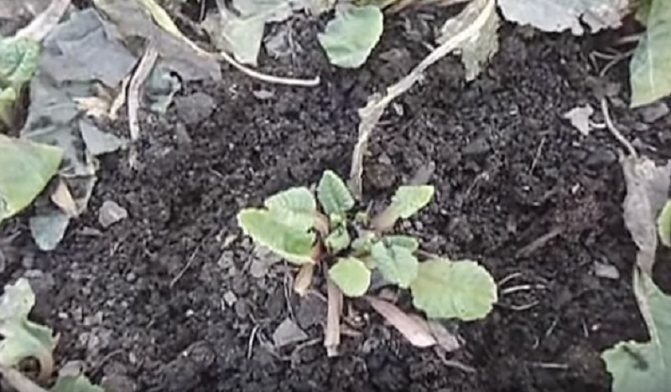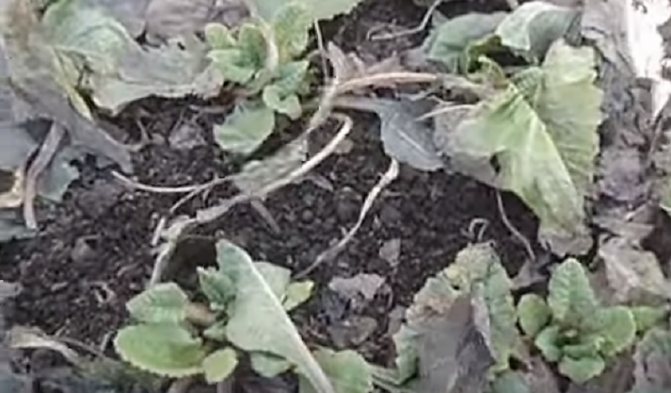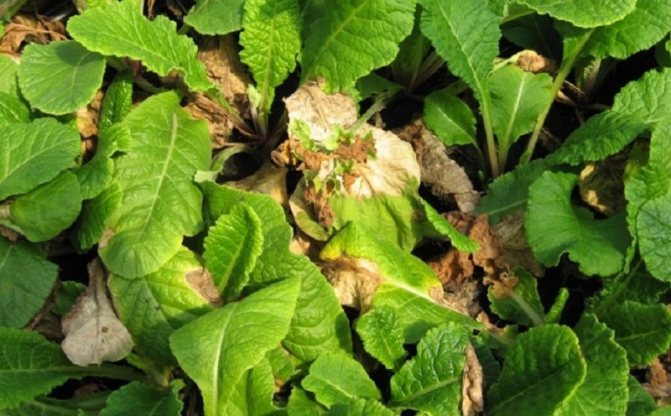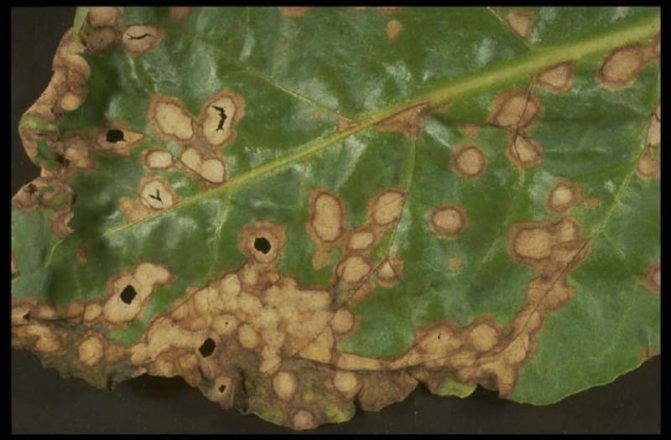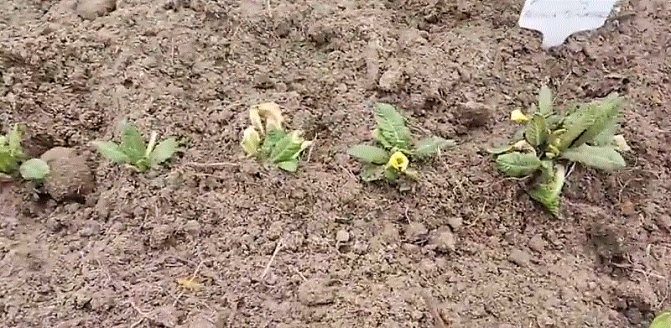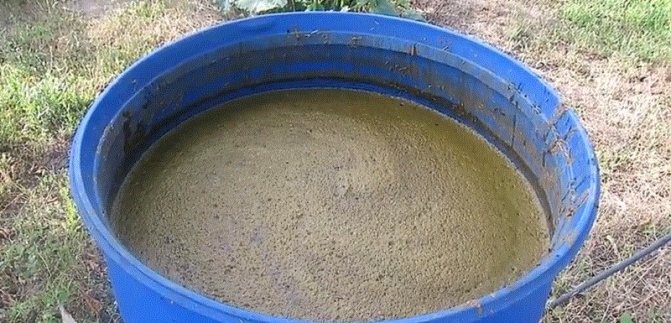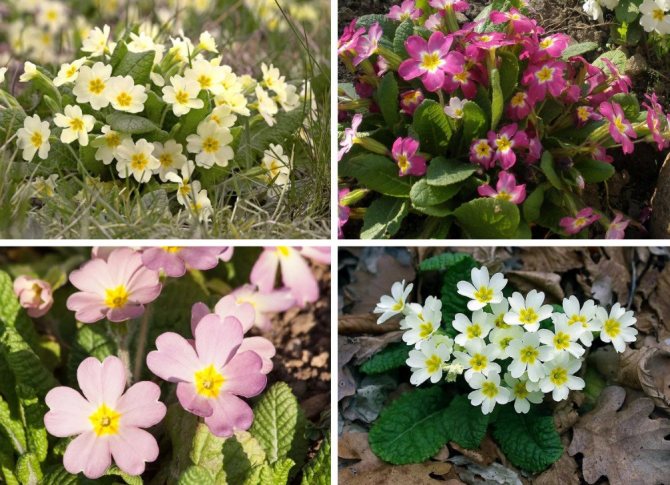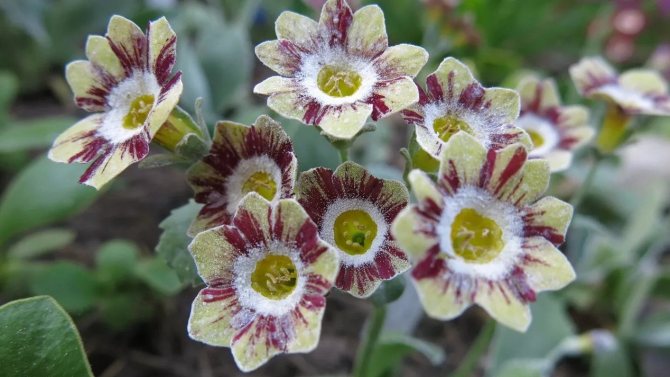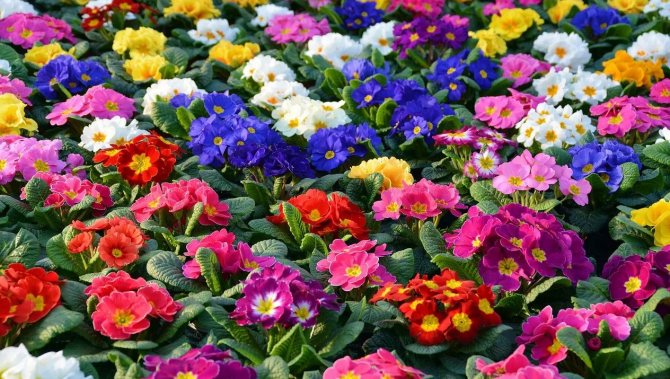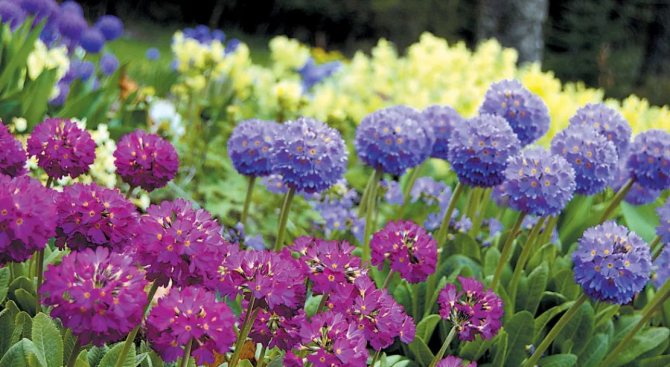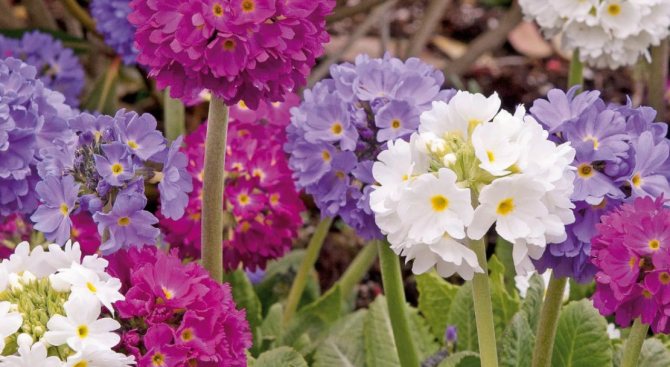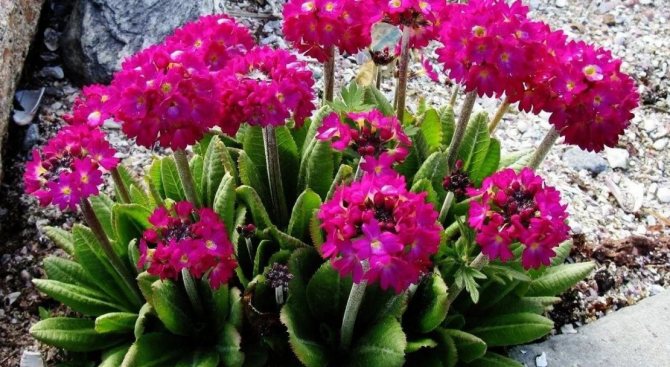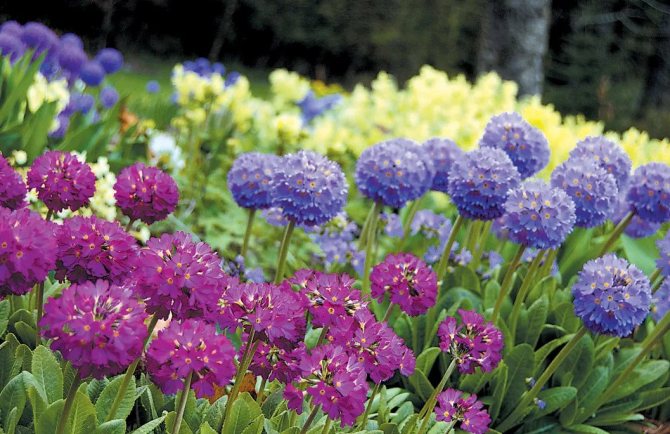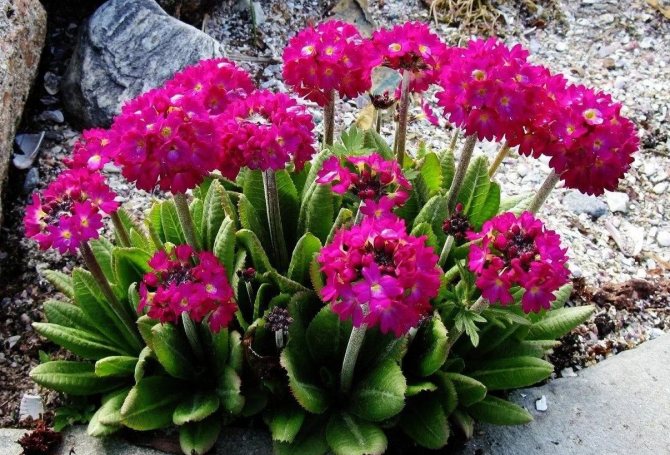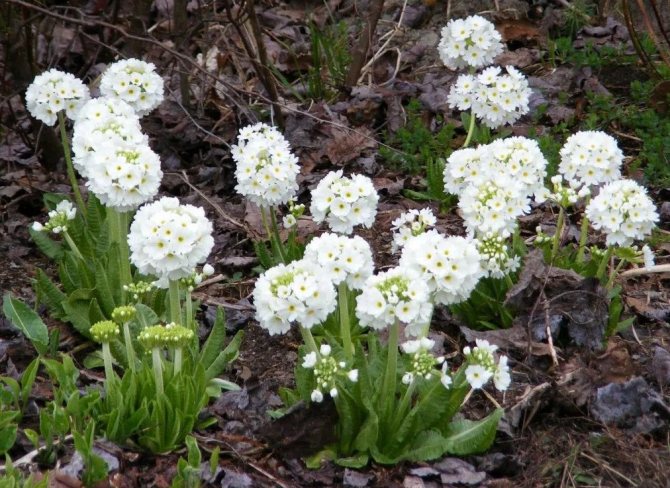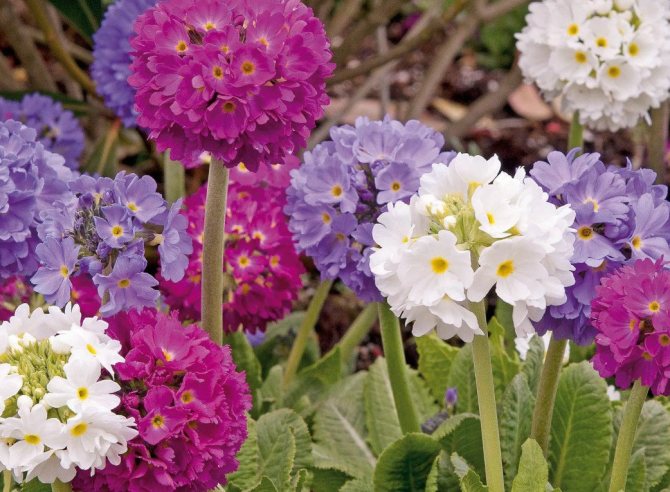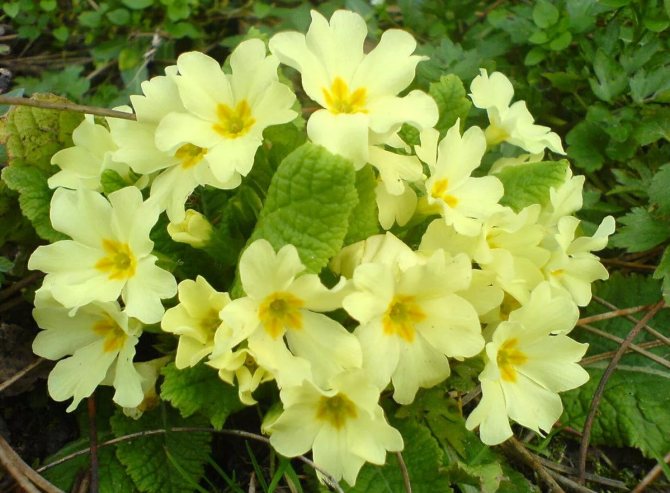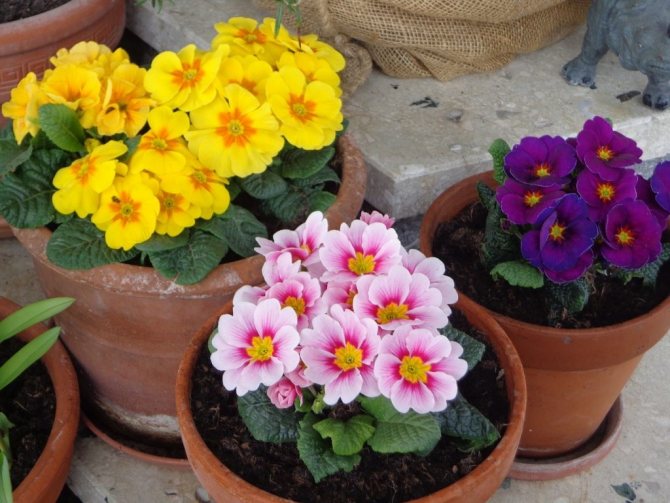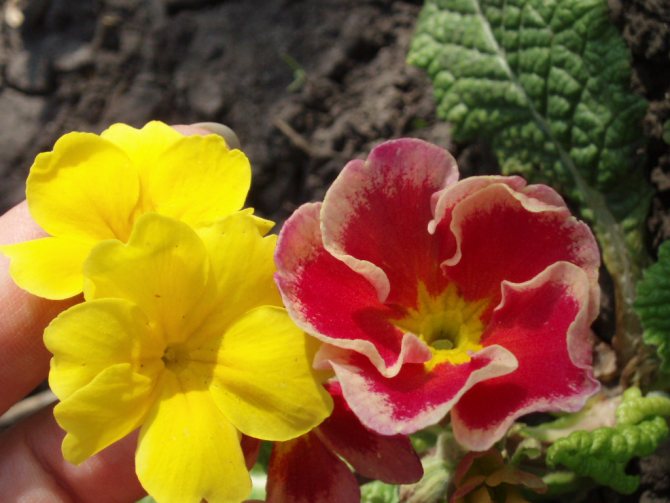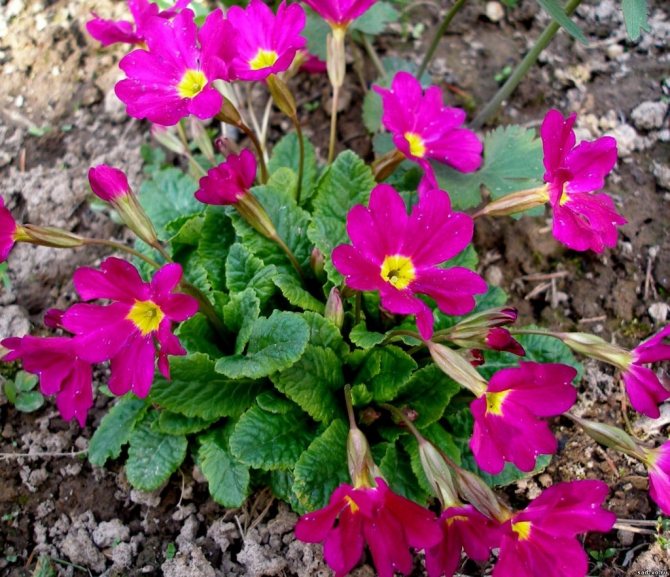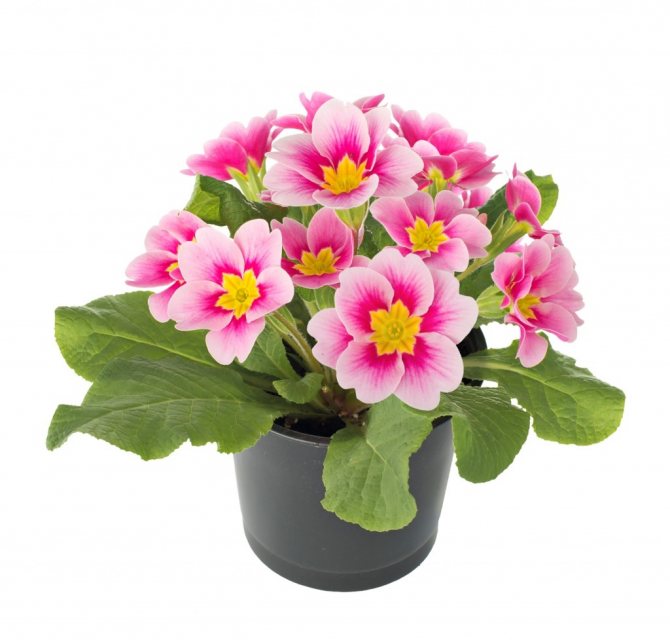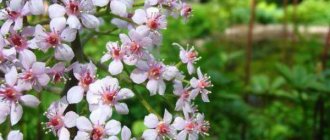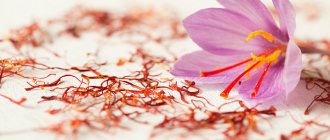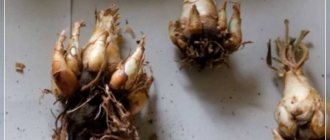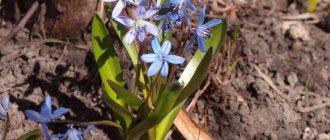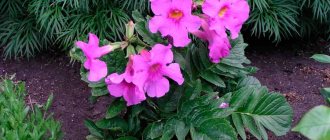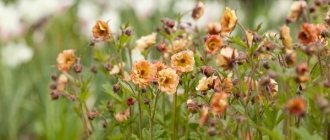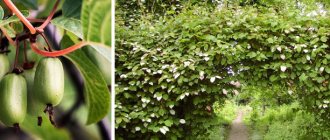Translated from Latin, primrose means "primrose"... There are about five hundred species of this flower, but no more than twenty are used for home breeding. In its natural habitat, the primrose prefers to settle on the banks of rivers and in the foothills. The birthplace of these magnificent flowers is considered to be South Asia and Africa, and it gained the greatest popularity in England. Every year the British hold exhibitions of their favorites, where new varieties appear.
Primrose flower description
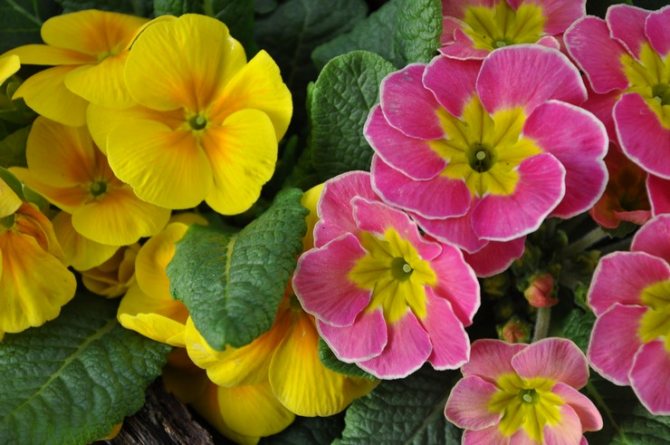
The plant flora of the Primroses genus includes many species that differ in color, structure and region of growth. The botanical literature mentions the names of 400-550 varietal specimens. However, scientists believe that flowers not mentioned in textbooks may be found in the wild. The main part of primroses is found in the countries of Central Asia, some species have taken root in Europe and North America. On the island of Java, only one representative of the Primroses grows. Primrose prefers wet areas, such as areas near the coast or low-lying meadows.
The plant has a developed root system. The leaves look elongated, ovoid and protrude from the basal rosettes. Some of the leaf blades are covered with wrinkles. They are colored gray-green and have a dense structure. The surface appears to be coated with wax. Peduncles are erect, devoid of vegetation. The tops of the heads are crowned with inflorescences of various configurations, which resemble protruding tubules. After the withering of the inflorescences, round polyspermous capsules are formed. In the garden plots, they are engaged in the cultivation of perennial and annual varieties. Primoa flower is suitable for home cultivation in flowerpots.
The most beautiful plant varieties
We have already talked a lot about the spectacular species that migrated from flower beds to window sills, and also learned how to care for primrose. Of the many varieties of this beautiful plant, the following are especially revered:
- Ear primrose - grown in greenhouses and has velvet flowers of unusual colors: cream, yellow, white, burgundy. It differs from other types in thick compacted foliage.
- Chinese primrose is a hybrid, reaching a height of 35 cm, with jagged leaves and a yellow eye inside the flowers. Loves coolness, can be grown in pots.
- Brilliant primrose is a persistent primrose with pink, white, orange and red flowers that can bloom singly without forming inflorescences. The leaves are covered with hairs.
Growing primrose from seeds
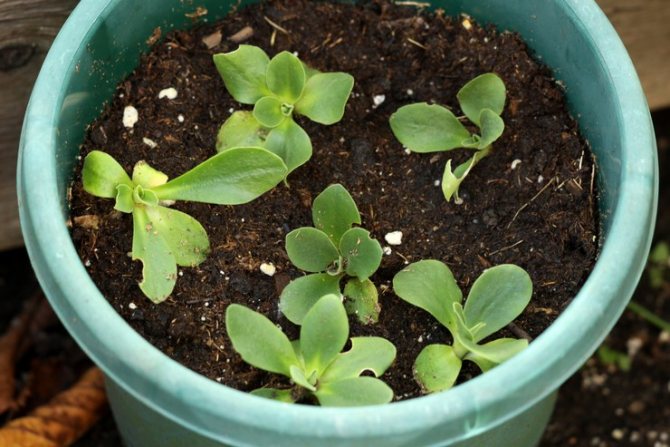

Sowing seeds
If the harvested seeds are stored in a box for a long time, they may lose their germination properties. Planting material can also be purchased at any garden store. Sowing is allowed to start in February. Seeds are carefully spread on the surface of the soil, consisting of leafy soil, sand and turf in a ratio of 2: 1: 1. For each square centimeter of soil, place up to 5 seeds, without covering it with earth, and lightly press against the soil.
The seed containers are covered with a bag and sent to the freezer for a month to carry out stratification. Then they are transferred to window sills located in the shade, and the first leaves are expected to appear. From time to time, crops are sprayed with water from a spray bottle.In order for the seeds to begin to germinate, it is necessary to maintain the air temperature in the room within 16-18 degrees. Almost all primroses stratify before planting. However, common primrose and fine-toothed primrose can skip this stage. The seedling formation process is quite long. Young seedlings are regularly ventilated to prepare and harden before planting. After 14 days, the bags are completely removed.
Seedling primrose
When 2-3 leaves are formed, the seedlings are dived into other containers using tweezers. Care and watering are carried out in the same way. If the seedlings are still growing strongly, they are thinned again. Seed cultivation has been carried out for several years before primrose is planted in open ground.
General rules for keeping plants in pots
We know that in the natural environment there is no more unpretentious flower than common primrose. Home care and maintenance in pots will require certain knowledge, skills and patience from flower growers. Some general points to consider when breeding a potted crop:
- The soil should not contain an increased concentration of mineral salts.
- Flowering is possible only with good lighting and a consistently low air temperature.
- Withered molds and inflorescences will interfere with the development of new shoots. In this regard, dried elements are promptly removed.
- Winter conditions of detention: a lit place with an air temperature of +15 degrees.
- Transplanting is possible only after the end of the flowering period. In this case, drainage is necessarily placed on the bottom of the pot.
- The plant is susceptible to gray mold damage. In this regard, fertilizers with a predominance of potassium and phosphorus are preferred. Treatment for the destruction of spores is carried out with a solution of soap and copper or 1% boric acid composition.


Planting primrose in open ground
Late spring or autumn is considered a favorable time for these events. The area where the flower will grow should be located near the trees in order to exclude the possibility of the bright midday sun getting on the leaves. We are not talking about those primroses that are found in the north. Such plants can be planted not only in the shade. Garden primrose prefers a moist and loose substrate with good drainage properties. Clay-rich soil will also work. If the soil is too heavy and dense, sand, vermiculite, chopped moss and organic fertilizers are added to the site during digging.
Between small seedlings, a distance of at least 10 cm must be observed, and larger ones must be planted away from each other. The flower does not develop well in open areas, so it is better to stick to compact plantings. Flowering can be observed after 2-3 years.
Soil formation
What features does a substrate have in its structure for planting such a plant as common primrose? Home care is impossible without well-drained soil. You can use commercially available geranium soil by mixing it with sandy soil in a 5: 1 ratio. Clean river sand is also suitable for compiling the substrate. If you prepare the land yourself, then for planting and keeping primrose take in equal parts deciduous, peat and turf soils. After mixing the substrate, also according to the 5: 1 scheme, add sand. Home primrose should be kept in a spacious, not very high pot. In addition, do not forget about the drainage layer of expanded clay balls.
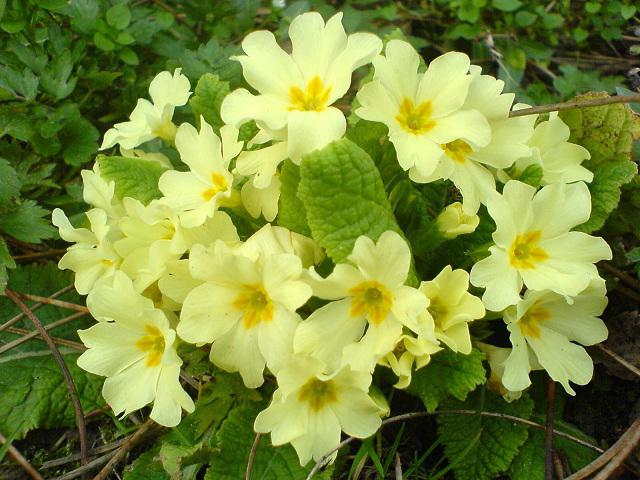

Primrose care in the garden
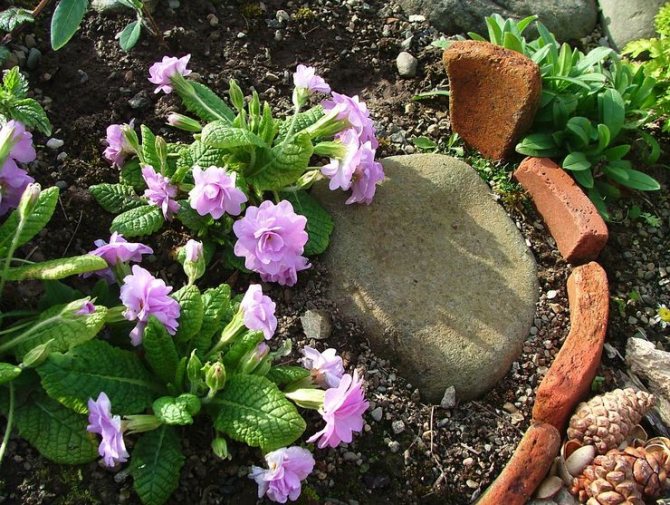

Watering
Caring for a garden primrose is quite simple. It is important to always maintain a moist environment and loosen the soil after watering or rain, removing weeds. During drought periods, watering is carried out more often. As a rule, about 3 liters of water is consumed for every square meter.
Top dressing and fertilizers
In addition to watering, primrose bushes need regular feeding with mineral fertilizers. The solution is prepared at a low concentration so as not to burn the roots. Top dressing is carried out every week after the first leaves appear.You should be careful with nitrogen fertilizers, otherwise it is easy to provoke a riot of foliage instead of the long-awaited flowering. Therefore, it is worth making a variety of top dressing, including enriching the soil with phosphorus and potassium fertilizers.
Transfer
Adult bushes are transplanted every 4-5 years. Planting primrose grows over time. For this reason, these primroses are also transplanted to a new site.
Summer period of existence
Reverse conical primrose in indoor conditions requires special attention. Directly in a pot, the plant should be taken out into the open air: into the garden, on the veranda, on the terrace. The main condition is that direct sunlight does not fall on the foliage. However, the space must be well lit. So that flowering does not stop in the summer, you need to carefully monitor the state of the substrate, preventing it from drying out. However, it is also not necessary to fill the plant. When a period with critically high temperatures comes, the plant is sprayed or the pot is placed on a tray with wet expanded clay. It is necessary to keep this variety of primrose with caution, due to the possible allergic reaction of the skin on the hands of a person.
When growing a plant in pots, many are interested in whether the primrose flower often needs feeding. Crop care, in particular the addition of mineral organic fertilizers in the summer, should be carried out every 2 weeks. A little later, in the period from November to February, when the plant begins the phase of active budding, feeding will need to be increased and carried out weekly.
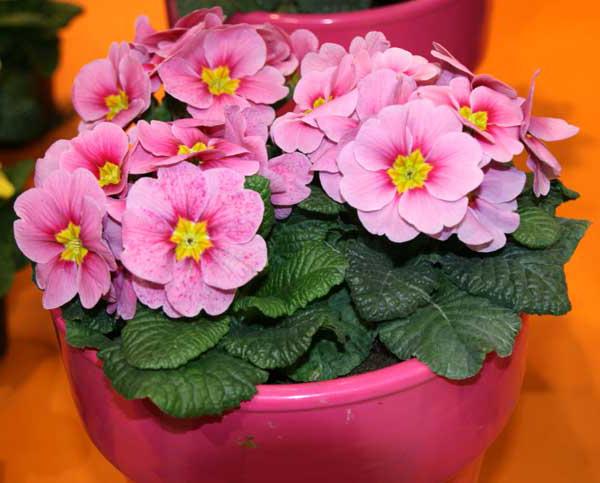

Garden primrose after flowering
When the plant sheds flower stalks, the area where the bushes are located is loosened and weeds are removed, being careful not to damage the leaf outlet. It protects the stems from freezing. You should not completely cut off the leaves, otherwise the plant will weaken and lose its decorative appeal. With the arrival of spring, the bushes rejuvenate, removing old and dry vegetation.
In regions where severe winters prevail, it is necessary to cover the bushes with straw or spruce branches. The Julia variety is the most frost-resistant and does without additional shelter. In the south, the flower winters beautifully under a warm cap of snow. Ice crusts that form on the site in spring are dangerous for shoots.
Reproduction of primrose
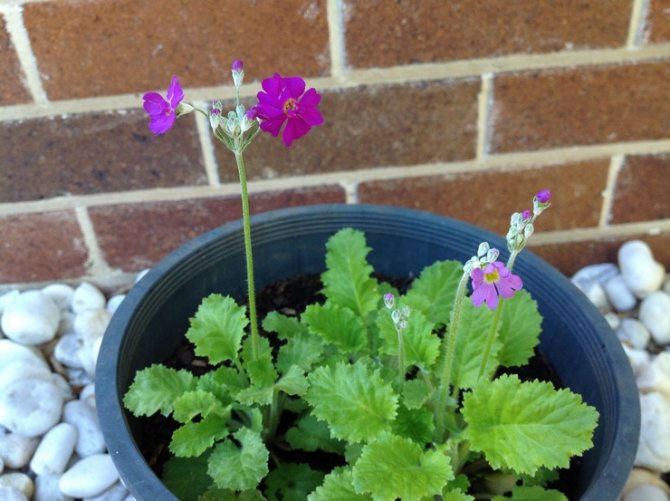

Primrose is propagated not only with the help of seeds, but also using cuttings of leaves and dividing the bush. When the plant reaches 4 years of age, it is watered and then carefully removed from the soil. The earth is shaken off, and the roots are washed under water. The rhizome, together with the shoots, is cut into several parts. Places of cuts are treated with ash. The resulting cuttings are transferred to another place and watered to strengthen them. Thanks to division, the leaves and stems are rejuvenated.
When the root system of the bushes is poorly developed, reproduction is performed using axillary shoots. To do this, separate the leaf, keeping the bud on the stem, and place it in slightly moistened soil. First, the leaf blade must be cut in half. The cuttings are stored in a lighted place at a temperature of 16 to 18 degrees in moist soil. After green shoots begin to appear from the buds, they are transplanted into flowerpots. The next year, mature and grown shoots can be transferred to open ground.
Combination with other plants
Due to the species diversity, primroses look good if several varieties are planted next to each other. Mono-plantings also look harmonious.
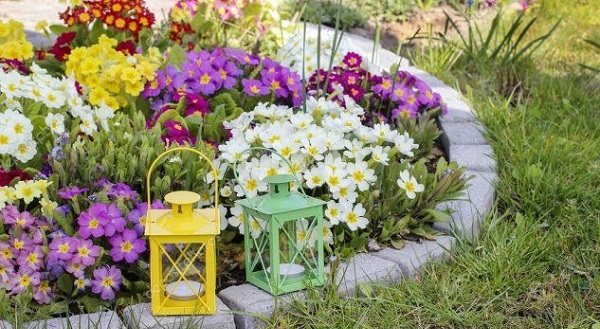

Primrose blends easily with taller perennials:
- peonies,
- phlox,
- daffodils,
- tulips.
A perennial plant goes well with fern, dwarf needles. The main thing is that the neighbors do not completely cover the primrose, but only slightly shade it. It is better to refuse the neighborhood with kupins, disporum. They grow strongly and with their shoots "stitch" the primrose through and through.
Primroses look harmoniously along the garden alleys, in groups on the lawn.She is decorated with rocky slides, artificial reservoirs. Low jagged and auricular species are suitable for creating a border, for planting around flower arrangements.
Primrose is a very colorful, bright flower that can decorate any piece of land. This primrose, due to its color scheme, is suitable for creating any flower arrangement in landscape design. You can grow primrose from seeds, and with proper care of the seedlings, you can breed a whole gallery of unsurpassed flowers.
Video - a description of a perennial primrose, as well as useful recommendations for flower growers about the nuances of planting and growing a perennial plant in the open field:
Diseases and pests
Often, the plant is under the threat of infection with rot, which covers the root collar and the surface of the stems. In addition, primrose leaves get sick with jaundice, powdery mildew and other dangerous infections. The signs of most diseases are changes in the color and shape of the leaves. Diseased shoots should be removed immediately to prevent the spread of the virus.
The vegetative parts of primrose attract the following insects: spider mites, weevils, aphids. The leaves are eaten by slugs and beetles. To combat the disease, chemical treatment of the bushes with Topsin's or Fundazol's solution is used. Spraying the leaves with one percent Bordeaux liquid is allowed. Such events are best done in the spring. For the purpose of prevention, at the end of the season, the flower is treated with a weak solution of Nitrafen. To get rid of bugs and slugs, you will have to work hard to collect them yourself, placing traps on the site.
Types and varieties of primrose
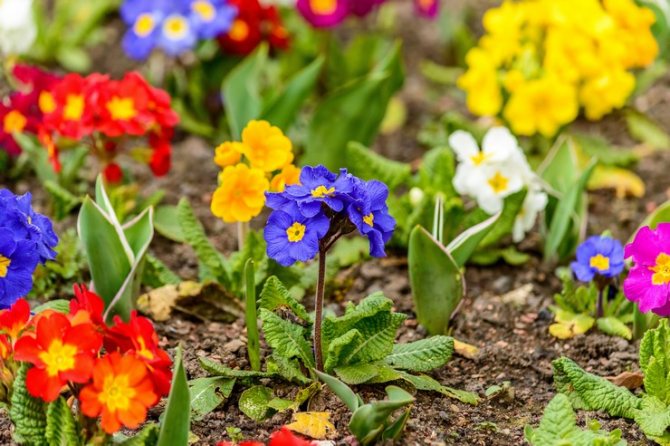

There is a huge variety of domesticated species and varieties of primroses. Let's consider the most common:
Common primrose - found in regions of Central and Southern Europe, where flowers bloom in the highlands after the snow melts. The species has thick roots and lanceolate leaves. The pale yellow and white flowers are arranged singly. Despite the short stems, the bushes look very impressive during the flowering period, which begins in March. Common primroses include Virginia, Giga White and Cerulea.
Primrose high - prefers climatic latitudes of Central and Southern Europe. The leaf blades are slightly wrinkled and elongated with protruding veins. Yellow buds are no more than 2 cm in diameter. April bloom. Breeders have managed to breed many hybrids from this species.
In addition to the varieties described, Siebold primrose and spring primrose can also be distinguished.
Community of green men
Primula, Primula, primrose. Perennial rhizome herbaceous plants, with a rosette of basal simple leaves, serrated or lobed along the edge. Flowers of the most varied bright colors, both monochromatic and two-colored, often with an eye, are collected in umbellate, capitate or, less often, whorled inflorescences. Flower stems are leafless. They usually bloom in early spring. Flower stems are leafless. The fruit is a capsule. Seeds are small, spherical or cylindrical, dark brown.
Etymology
The name of the genus comes from the Latin primus, which means "early", "first", since most primroses are spring-flowering plants.
The spring primrose inflorescence is shaped like a bunch of keys. Therefore, one of the popular names of the plant is "keys". In Europe it is also called "the keys of the Apostle Peter". There is a belief that the primrose appeared from a bunch of keys to paradise, which the Apostle Peter dropped from heaven to earth.
Types and varieties of primrose
One of the most numerous genera of the world's flora, according to various sources, there are from 400 to 550 species of these plants, distributed throughout the globe. Some species grow in very specific ecological conditions. Such species are difficult, and often impossible, to grow in flower beds. Fortunately, there are quite a few, about 200, species that can be cultivated without much difficulty.
More often than others are cultivated: Voronov's primrose (Primula woronowii), common primrose (Primula vulgaris), Julia's primrose (Primula juliae); spring primrose (Primula veris); high primrose (Primula elatior); rejected primrose (Primula patens) - differs in later flowering; ear primrose (Primula auricula) with fragrant flowers in an umbrella-shaped inflorescence, many varieties; fine-toothed primrose (Primula denticulata) with spherical inflorescences: Japanese primrose (Primula japonica) blooms later than other species (in June-July), not winter-hardy and other species.
Most species of primrose bloom in early spring, many plants already bloom right out of the snow. The growth and development of inflorescences occurs in primroses in the winter and spring months under the snow. Once the snow melts, fully formed shoots begin to grow rapidly and the primrose soon blooms.
Primroses classification
German experts have proposed a classification of primroses, which is convenient for flower growers, based on the shape and arrangement of inflorescences or flowers on plants. There are five groups in total.
Cushion primroses
The flowers are single, each on its own short peduncle, slightly towering above the rosette of leaves (Primula Voronova, small primrose, common primrose, Julia's primrose, etc.)
Umbrella primroses
The flowers are collected in a one-sided or round umbrella, towering over a rosette of leaves on a peduncle up to 20 cm high. (Spring primrose, high primrose, rejected primrose, pink primrose, ear primrose, ear primrose hybrids, etc.)
Capitate or globular primroses
The flowers are collected in dense capitate inflorescences on a strong peduncle, the height of which during the flowering period is 15-20 cm, and during the fruiting period - 30-45 cm. (Primula capitate, fine-toothed primrose and its varieties).
Longline or candelabra primroses
The flowers are collected in whorled inflorescences, consisting of several tiers, located on strong peduncles and very similar to candelabra. (Japanese primrose, Biss primrose, Bulley primrose, etc.)
Bell-shaped primroses
The inflorescences consist of drooping or drooping flowers and are located above a beautiful rosette of leaves on peduncles of various heights. (Alpine primrose, Sikkim primrose, Florinda primrose.)
Cushion primroses
Common primrose or stemless primrose (Primula vulgaris, Primula acaulis)
Homeland - the forests of Europe. It has been known in the garden culture since the 16th century.
Evergreen perennial up to 20 cm high. Leaves are basal, ovate, toothed along the edge. Flowers up to 3-4 cm in diameter, arranged one by one on pedicels up to 3 cm long. Corolla is light yellow with a yellow throat, varieties - pink, lilac, white, have double forms. It blooms from the end of April, for a long time - up to 50 days.
The plant is winter-hardy and cold-hardy, it develops well both in open areas and in partial shade.
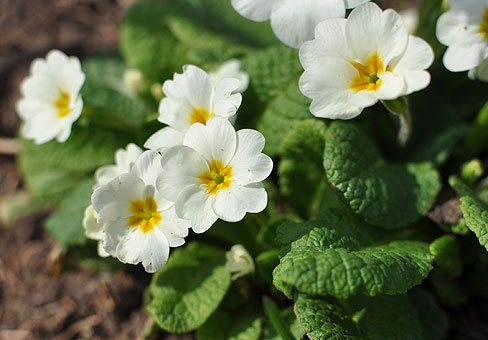

Common primrose
Popular varieties and varieties of common primrose:
‘Virginia’ - white flowers with a light yellow throat;
‘Coerulea’ - corolla up to 2.5 cm in diameter, blue with a yellow throat;
‘Gigha White’ - white flowers;
a variation of var. sibthorpii (subspecies Sibthorp) - pink, lilac flowers;
'Zebra Blue' - NEW 2011, hybrid (F1), plant 10-12 cm tall with white flowers with narrow white stripes and yellow center, 4-5 cm in diameter.


Hybrid varieties of common primrose
In flower shops and garden centers, you can often find an amazing variety of shapes and colors of Primula acaulis, Primula elatior, Primula xpoliantha hybrids, including terry, two-colored, bluish shades unusual for primroses. They are usually sold already in bloom. Unfortunately, these varieties are bred specifically for potting and are not sustainable outdoors. Sometimes it is still possible to keep such plants in the garden, provided they are placed in an area protected from direct sunlight, abundant watering, and preventive shelter for the winter.
Primula Voronova (Primula woronowii)
Homeland - the forests of the Caucasus.
Evergreen racemeal perennial, 25-30 cm high. Numerous - more than 50 - delicate lilac flowers appear in April-early May, bloom for about 3 weeks.
Gives self-seeding.
Small primrose (Primula minima)
Homeland - Eastern Alps, central regions of the Carpathians, Balkans.
The smallest of primroses. Pink-red flowers up to 3 cm wide, similar to stars, sitting on short peduncles. Blooms in May-June.
Primula Julia (Primula juliae)
Homeland - the mountain forests of the Caucasus.
Evergreen creeping perennial up to 10 cm high. Corolla funnel-shaped or flat, raspberry-purple, up to 3 cm in diameter, with a yellow eye. The blades are narrow with a hollow. Blooms in May, profusely.
There are many varieties with flowers of various colors.
It grows quickly. Propagated by seeds and vegetatively.
Umbrella primroses
Primula high (Primula elatior)
Homeland - the forests of Europe. It has been mentioned in culture since 1534. The ancestor of numerous varieties and complex hybrids obtained from crossing with spring primrose and common primrose.
A perennial plant, reaching a height of 20-30 cm during the flowering period. The leaves are large, light green, wrinkled, petiolar, collected in a basal rosette. The flowers are light yellow, 2 cm in diameter, collected in 7-10 umbellate inflorescences. Blooms from the end of April 35-40 days.
Under the general name Elatior Hybriden, varieties bred with the participation of tall primrose are used in ornamental floriculture - plants with fairly large flowers of creamy white, burgundy, yellow, pink in all kinds of shades. Many varieties are short-lived and can be grown as biennials.
Spring primrose or medicinal primrose (Primula veris)
Popular names: "Rams", "white letter", "lambs", "golden keys".
English name Cowslip.
Homeland - the forests of Europe. Grows in meadows and forest edges. It is mentioned in culture until the 16th century.
Evergreen short-rhizome perennial. The leaves are ovate-oblong, wrinkled, bright green, crenate along the edge, petiolate, collected in a basal rosette. Peduncles up to 30 cm tall. The flowers are yellow, up to 2.5 cm in diameter, with an orange spot in the throat, collected in an umbrella-shaped loose inflorescence up to 6 cm in diameter. It blooms in mid-April, after the snow melts.
A relatively drought-resistant species.
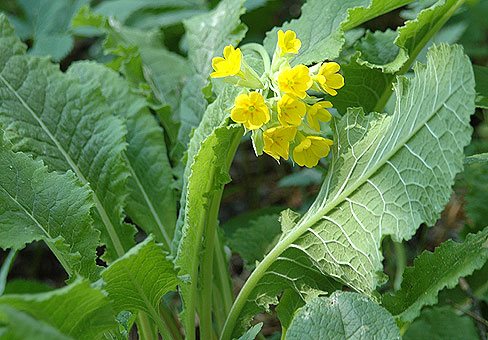

Spring primrose
Polyanthus primrose or multiflorous primrose (Primula poliantha)
A group of highly decorative garden hybrids obtained by crossing Primula acaulis, Primula veris, Primula elatior, Primula juliae with each other, sometimes with the participation of other species. This primrose is similar to Primula elatior, but has larger, up to 6 cm in diameter, fragrant, variably colored flowers, collected in 5-15 umbellate inflorescences. Peduncles 10-30 cm high, depending on the variety. It blooms for a long time, from mid-May to late June. Removal of wilted flowers significantly extends the flowering period.
The plant prefers well-lit areas that are inaccessible to direct sunlight at noon. For the winter, a light spruce cover is recommended.
Primula ear or primrose auricula (Primula auricula)
Homeland - the Alps and the Apennines, grows on rocky, often calcareous slopes and rocks.
Perennial plant up to 20 cm high with dense leathery leaves, slightly mealy on the underside. The flowers are pink or purple-violet with a yellow eye, faint-hearted, collected in a multi-flowered umbrella-shaped inflorescence (up to 30 pieces). Blooms in late April - May, blooms for about 40 days.
The plant is unpretentious, durable and winter-hardy, has hibernating leaves and retains decorativeness from early spring to late autumn. It grows well both in open places and in partial shade, requires abundant watering during dry periods.
Auricula hybrids
The most popular and widespread hybrids were obtained in the 16th century. from the crossing of the primrose itself and primrose bristly and have a common botanical name pubescent primrose (Primula x pubescens).According to the horticultural classification, they constitute the Auricula Hybrids group.
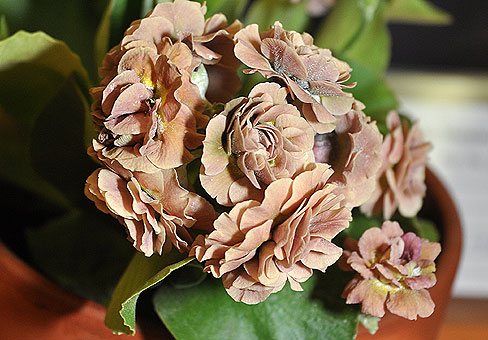

Primula aurikula cultivar Samantha
Group of exhibition auricles:
Representatives of this group are distinguished by the presence of a powdery bloom.
Edged - the rim is divided into two concentric color zones;
Plain;
Shaded - the colored part of the rim is streaked with radial strokes;
Smart - include everything that is not included in the previous groups.
Alpine auriculum group
Plants of this group are naked, without plaque, in contrast to the show auricles. These hybrids are colored in bright and clear tones that are very varied, with a transition from a more saturated shade around the eye to a lighter edge. The center is either yellow or light. Recently, the so-called "lace" varieties have become especially popular, in which the eye and each petal are outlined with a contrasting line.
Group of terry auricles
Evening primrose with 1-2 rows of petals and additional randomly spaced petals in the center.
Group of curb auricles
Strong plants forming groups of rosettes with numerous peduncles.
The most easy to care for are border and partially terry varieties. Hybrid auricles prefer clay soils, grow better in partial shade.
Cortus primrose (Primula cortusoides)
A perennial plant, reaching a height of 40 cm during the flowering period. The leaves are ovoid, dentate along the edge, with hairy pubescence. The flowers are pink-purple, up to 2 cm in diameter, collected in a few-flowered umbellate inflorescence. Up to 25 peduncles develop simultaneously on one bush. Blooms in late May and early June, about 40 days.
The cortical primrose has a very decorative 'Alba' variety with white flowers.
Popular varieties of primrose cortusoid:
‘Alba’ - peduncles up to 30 cm tall, white flowers with a yellow fauces, 2 cm in diameter, collected in capitate inflorescences about 8 cm in diameter;
‘Grandiflora’ - purple flowers, large, about 2.5 cm in diameter, inflorescences 10 cm in diameter;
Kashmir variety (par. cacbemiriana) - bright purple flowers, about 0.7 cm in diameter, inflorescences with a diameter of 8 cm. Requires light shelter for the winter.
Siebold primrose or rejected primrose (Primula sieboldii, Primula patens)
Japanese name - Sakurasou.
Homeland - South Siberia and the Far East.
A perennial plant with oval petiolate leaves with large toothed edges, collected in a basal rosette. The flowers are purple with a white throat, 2.5 cm in diameter, collected in 6-15 pieces in an umbellate inflorescence. Peduncle about 30 cm high. It blooms for 20-25 days, from the end of May. Thanks to thin long, branching rhizomes on light, fertile soil provided with moisture, the plant grows rapidly, forming beautiful clumps. Prefers semi-shaded areas.
The Japanese affectionately call this primrose sakurasou (sou - "plant", sakura - "sakura"). Sakurasou is very much loved by all Japanese people. In the 17th and 19th centuries, Siebold's primrose occupied vast areas in the suburbs of Edo (Tokyo) in the wild. In the 19th century, botanist Dr. Philip Franz von Siebold introduced primrose to the West, and since then it has been named after him. And already in 1812 88 varieties were described and illustrated in the book "Sakurasou Kahinzen".
Cultivars range from carmine red, pink, white to lavender and purple (no orange, yellow and blue). There are two-tone varieties. Some varieties have edging along the edge of the petals, there are varieties with bright eyes, for example, red or white.
Flowers can be flat, goblet, cup-shaped, saucer-shaped, bud-shaped. The diameter of the flowers varies from 2 to 6 cm.
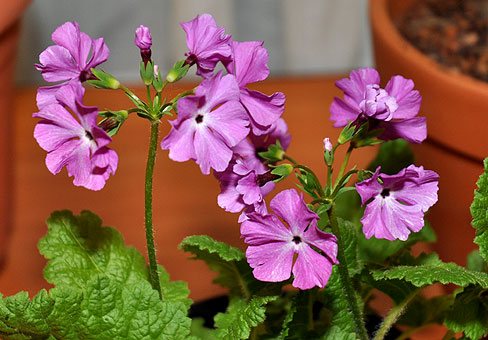

Primula of Siebold, or Primrose of Siebold
Primula pink (Primula rosea)
At the beginning of flowering, the peduncles are almost invisible, but over time they lengthen. By the end of flowering they reach 12-15 cm. Blooms in May, pink flowers, rather small (1 - 1.2 cm).The rosette begins to grow vigorously only at the end of flowering. Before and during flowering, young leaves are greenish-bronze, but as they grow, they turn pale green.
The rose primrose prefers the swampy soils of the stream bank, although it feels good in drier places.
Capitate or globular primroses
Small-toothed primrose (Primula denticulata)
Homeland - mountain meadows in the Himalayas.
Perennial plant with large oblong leaves, serrated along the edge, with a mealy bloom on the underside. The flowers are pale, lilac-pink with a yellow throat, collected in a capitate inflorescence up to 10 cm in diameter, the flower arrow at the beginning of flowering has a height of about 15 cm, at the end it can stretch up to 50 cm or more (usually about 40 cm). Blooms from April 30-40 days.
Hardy without shelter, develops well in semi-shady areas and in open places.
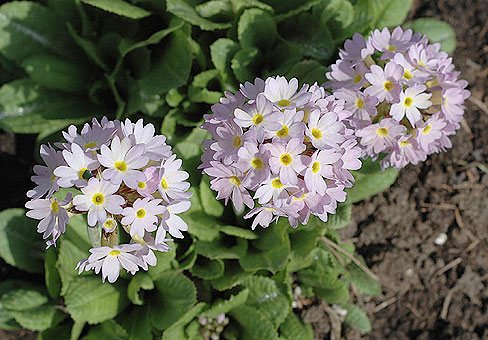

Fine-toothed primrose
Primula capitate (Primula capitata)
A plant with small purple-violet flowers, collected in a capitate inflorescence. A distinctive feature is a mealy bloom, which is sprinkled with all flower cups, peduncles and leaves. On the outside, the leaf blade is only slightly powdered, but the lower part of the leaf is covered with a bloom of such a thickness that it seems almost white. Blooms from mid-June to late July.
In the conditions of central Russia, the capitate primrose does not hibernate, therefore it is grown as an annual.
Longline or candelabra primroses
Japanese primrose (Primula japonica)
Homeland - Kuril Islands and Japan.
A plant with light green large pubescent leaves up to 25 cm long, collected in a basal rosette. Peduncles rise to a height of 50 cm. The flowers are crimson, less often white, 2 cm in diameter, located on the peduncle in whorls in several (usually up to five) tiers. Blooms from mid to late June, about 30 days.
Hardy, but in frosty, snowless winters it can freeze slightly.
Primula Biss (Primula beesiana) with bright purple flowers and Bulley's primrose (Primula bulleyana) - with golden yellow, appearing in June-July, also belong to this group of primroses.
Bell-shaped primroses
Viala primrose, orchid primrose (Primula vialii)
Homeland - Northwestern province of Yunnan - southeastern province of Sy-Chuan (China). In the mountains at altitudes of 2800–3350 m.
The plant is 10-15 cm high with a rosette of basal oblong wrinkled leaves. The flowers are small, collected in a spike-shaped inflorescence, before blooming, the buds are painted in bright red. The blooming occurs gradually, while the spike changes color. Blooms in June-July for 3-4 weeks.
For planting, choose a place in the light shade of shrubs on fertile, well-moistened soil. It is considered to be short-lived, lives longer on fertile soil rich in humus.
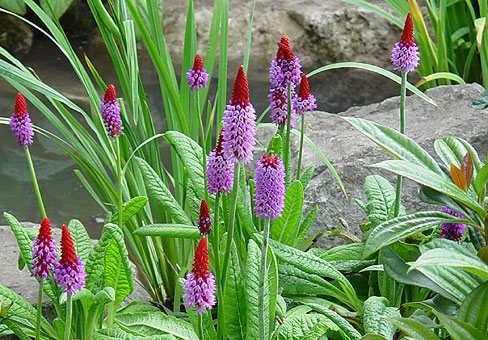

Viale primrose or Viale primrose
Sikkim primrose (Primula sikkimensis)
Homeland - Himalayas. In the wild, it grows in southern Tibet at an altitude of 3500 to 5000 m, mainly along wetlands and stream banks.
Forms an inflorescence of 25-30 yellow flowers. Blooms in June-July for three weeks.
Florinda primrose (Primula florindae)
Homeland - China.
Peduncles up to 50-70 cm high bear a dense drooping inflorescence of bright yellow flowers. Blooms from mid-June to early August. Known hybrids with orange-red flowers and a shorter flowering period.
In room culture cultivate such types of primrose as: reverse conical primrose, soft primrose, common primrose.
If varietal Primula elatior blooms poorly and for a short time, gives too small flowers that quickly fade or wither, transplant the plant to a shady place, preferably to an area under deciduous trees. Add peat when preparing the soil.
Primrose care
Primroses are extremely decorative, durable and unpretentious. They deserve the widest possible use in landscape design.
Shaded areas, cultivated loose clay soils that contain many nutrients and retain moisture - that's, in principle, what primroses need. When preparing the site during digging, well-decomposed compost is added, peat and leafy soil are introduced on light sandy soils, and sand is added on heavy soils. Watered regularly, without letting the soil dry out, carefully weed out the weeds. After flowering, the plants are fed with mullein infusion or complete mineral fertilizer at the rate of 20-30 g / sq. m.
Reproduction of primrose
Propagated by seeds and dividing the bush. Seeds are sown in the harvest year before winter in open ground or in early February.
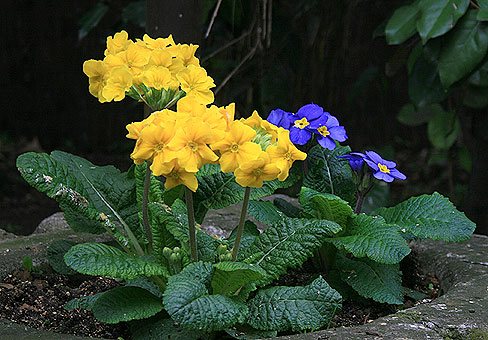

Green pharmacy
Spring primrose, "rams", "keys" - a valuable vitamin plant. A salad made from its leaves is useful: young primrose leaves are spread on slices of boiled beets, sprinkled with green onions, and poured with vegetable oil. Spring primrose rhizomes are used in decoctions as an expectorant.
Spring primrose in legends
The most common legend about the origin of the spring primrose is that the Apostle Peter, guarding the gates to paradise, accidentally defended the keys to the gate, and in the place where they fell to the ground, yellow flowers grew, which they called the primrose - Keyflower.
The English name Cowslip is associated with cows: where the cow was, primrose bushes grew there.
In Ireland, primrose wreaths were tied to the tails of cows and hung on barns to prevent fairies from stealing milk.
Another name for primrose - Paralysio - comes from the name of the ancient Greek youth Paralysos, who, suffering from paralysis, died of love, and the gods turned him into a flower. It was the Greeks who considered primrose to be the remedy with which all the gods were treated.
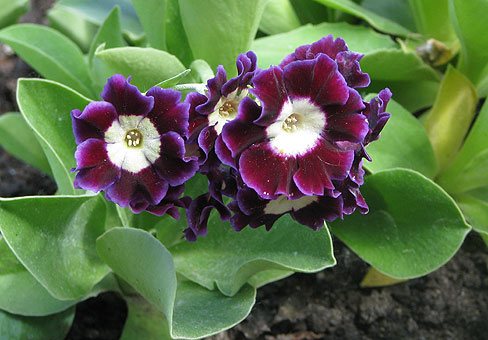

Ear primrose, or auricula
The ancient Scandinavians believed that primrose grew where the goddess of spring Freya touched the ground with her rainbow necklace. In Germany, they believed that she helped find treasures, and in England they thought that gnomes and fairies lived in her bells. Although, it should be noted that historians may be mistaken in determining the type of primrose. It is possible that some of these legends refer to a different species, namely to the common primrose (P. vulgaris).

